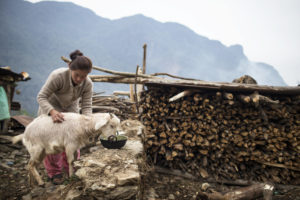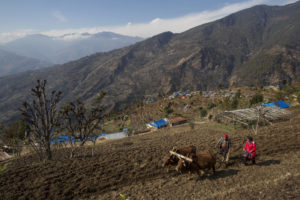Sumina Tamang rose before dawn to take her goats out to graze on a hilly green pasture. On the way home, she stopped by a neighbor’s house to check on a cow that was limping and acting lethargic. After noting its symptoms and chatting with the owner, Tamang entered her observations and the GPS coordinates into an app on her smartphone. She snapped a few photos before submitting the entry to Nepal’s Department of Livestock Services.

Tamang’s high-tech reporting is a lifesaving revolution in a rural economy where roughly 87 percent of households keep some form of livestock. Tamang reported on the livestock health of her entire village of Kimtang, which includes about 80 households in Nepal’s Nuwakot District, as part of a project led by biomedical sciences Professor Richard Bowen and funded by the United States Agency for International Development. The project empowered women to improve the detection and control of livestock diseases in rural areas.
“Seventy percent of all livestock-related work in Nepal is carried out by women,” said Renu Shakya, a Kathmandu-based researcher, lecturer at Tribhuvan University, and co-leader of the project. “Nepal depends heavily on livestock production for food security and livelihoods, and there is a need for better livestock health in many of these remote villages.”
Empower and educate
The project recruited 15 women from different villages scattered throughout the districts of Nuwakot and Dhading in Nepal and trained them to use a smartphone app designed by Bowen. The women used the app to contribute to a rapid reporting and response network for livestock disease outbreaks in rural areas. They all owned livestock and ranged in age from 20 to 30 years old. Most of them already had their own smartphones and were able to quickly learn and become familiar with the app’s software.
The hugely successful yearlong pilot project, which ended in Spring 2018, generated 1,042 disease reports and led to the quick control of a major hemorrhagic septicemia outbreak in cows and buffalo that occurred in the Nuwakot District. Because of the rapid reporting system, officials were able to immediately start vaccinations to control the outbreak.

Over the course of the project, the women’s communities began to look to them as leaders who could provide valuable guidance for dealing with sick livestock. Tamang often found herself in the position of being asked for advice or prescriptions that she could not give.
“As the villagers’ expectations grew, many of the women felt the need to learn more,” Shakya said.
In addition to serving as the official reporters for animal health in their communities, the women received trainings on livestock disease identification and prevention. The project also provided livestock health outreach programs in schools to spark interest and engagement among local youth.
“The women took pride in their work and earned a great deal of trust and respect from their communities,” Shakya said. “All of them have asked me when they can start reporting again.”
Tamang’s experience with the project led her to begin formal training as a village animal health worker. She hopes to eventually open a small animal care clinic in Kimtang.
“This project has been very beneficial for me and my community,” Tamang said. “It inspired me to pursue education, so that I can prescribe basic medications to farmers in my community and help them get quick treatment for their sick animals.”
Flip the status quo
The idea for the project originally came from Bowen’s time as the director of a USAID livestock innovation lab, which frequently sent him to work in Nepal. He learned that the government was often unaware when livestock outbreaks occurred, particularly in rural areas where veterinary care is lacking.

“Most countries, including the U.S., have a top-down model for controlling disease where government authorities are the ones who monitor things,” Bowen said. “The idea with this project was to flip that and try a bottom-up approach.”
“The Nepali government loves the system and wants us to scale it up,” Bowen said. “It was very successful, but there is more work to be done. We now need to work on the response infrastructure.”
Bowen and his USAID collaborators are currently looking for partners to help support the continuation and expansion of the project and would like to eventually see the system used in other countries as well.
“This was a very important project and we need more of them,” Shakya said. “When women are empowered and serving their communities at the same time, it benefits the entire country.”